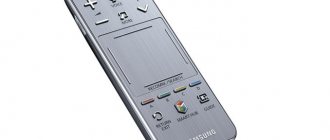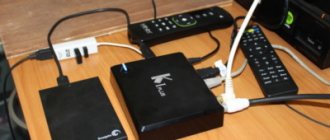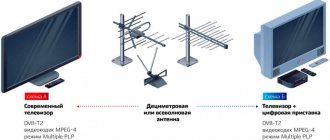FL FSUE "RTRS" "KRASNODAR KRTPC": address, phone, fax, email, website, work schedule
"RUSSIAN TELEVISION AND RADIO BROADCASTING NETWORK" "KRASNODAR REGIONAL RADIOTV TRANSMITTING CENTER", BRANCH OF THE FEDERAL STATE UNITARY ENTERPRISE
Region: Krasnodar region Krasnodar
Address: 350038, KRASNODAR, st. RADIO, 3A
Phone: no information
Fax: no data
Email: no data
Website: no data
General director / responsible person / owner of the FL FSUE "RTRS" "KRASNODAR KRTPC": no data
Working hours: Mon-Fri: 7-18, Sat-Sun: closed
Found an inaccuracy in the description or want to provide more information about the company? - Write to us!
Detailed information about the FL FSUE "RTRS" "KRASNODAR KRTPC": accounting, balance sheet. Download bank details, tenders, credit history, taxes of the FL FSUE "RTRS" "KRASNODAR KRTPC".
Terrestrial digital TV
Content
Terrestrial digital free television.
Purchase, installation, configuration, assembly, connection, exchange, installment plan and repair of antennas and digital TV receivers in Krasnodar, Severskaya, Dinskaya, Adygea, Starokorsunskaya, Afipsky, Goryachy Klyuch, Enem, Takhtamukai, Yablonovsky, Novoznamensky and the region.
Kit for installing an antenna and set-top box for terrestrial digital television on TVs without a built-in DVB T2 format module. COST 3500 - 4000 rub.
Kit for installing an terrestrial digital TV antenna on modern TVs with DVB T2 support. COST 2500 - 3000 rub.
From us you can buy a digital set-top box and order a number of services: installation, configuration, installation and connection of antennas, set-top boxes, free digital television receivers in Krasnodar, Adygea and the region.
Setting up terrestrial digital TV.
You can receive free digital television channels by connecting your antenna to your TV or receiver. But for more reliable reception of digital television channels, it is recommended to buy a special external digital antenna designed specifically for the DVB T2 format. In places with a strong signal, you can also use an internal antenna with reception gain adjustment.
We can configure the antenna more precisely as follows: connect the receiver to the antenna using a coaxial cable, connect the set-top box to the TV using an RCA cable, if you have an analog “pot-bellied” TV and a connection via the HDMI protocol is suitable for modern TV.
We go to the menu and in the “ automatic search” for channels we scan programs; in the process, a message will appear for quite a long time about the number of channels found; upon completion, you need to confirm the saving of the programs.
There is a faster way to find all the necessary programs: find the “ manual search” item, select channels 39 and 60 one by one, pay attention to the two scales.
The first "strength" of the signal, predominantly always full, indicates the correct connection between the receiver and the antenna. Next, we are concerned about the “quality” , turning the antenna we bring it to the maximum and approximately maintaining the direction to the base station located on the territory of the Kuban stadium.
When you finish setting up the signal, go to the search section and perform it on each band, on the first frequency you will find 10 channels, then save them, select the second, click on search and also repeat the previously performed procedure.
In any case, you will receive 20 well-known and watched daily channels in excellent quality, not dependent on the vagaries of weather or technological obstacles.
Advantages of terrestrial digital television.
- The complete absence of fees for viewing television channels, according to the draft federal program for quality TV, is one of the most popular ways to get an excellent image on your TV screen.
- The stability of the picture is not affected by weather conditions, high obstacles of natural or artificial origin that block the transmitting television station, the image is always clear, without flickering, ghosting or “snow”.
- Using modern equipment, you can play video and audio files, connect to the Internet and view downloaded lists of IP programs.
Problems of terrestrial digital TV.
There are times when the installed digital TV set does not work correctly, the image constantly “freezes ,” crumbles into “cubes,” the sound is distorted, or you generally see the message “no signal” on the TV screen.
This does not contribute to comfortable viewing of TV shows, but the situation can be improved by using signal amplifiers, which have a huge variety of amplification levels; you can choose the right one according to its parameters specified in the instructions for the amplifier.
Of course, at first glance, installing and configuring digital TV is an easy process, in principle it is, but it is better to entrust the matter to the experts, for example from our company, they will help you choose and buy , deliver , install , configure and connect digital TV and you will have one guarantee one year for all equipment.
In 2014, terrestrial digital television was launched in Krasnodar. This event had a positive impact on image quality; first, the first multiplex was launched, including 10 video channels in HD format and three audio, two years later they added 10 more channels in this quality.
All programs are broadcast free of charge , this is the result of a project to transition from an analogue, morally and technically outdated broadcast format to a new digital one, designed to significantly improve image and sound parameters. For high-quality and stable viewing, you need a TV that supports DVB - T2, if you have a working TV of the previous generation, then you need to buy a digital set-top box DVB - T2 , which converts digital transmissions into analogue ones, received by your TV, while the picture on the TV remains high level.
TERMINAL TELEVISION INSTALLATION KITS:
- Aluminum antenna "Mir 12" or "Spectrum 4".
- Bracket or mast for installing the antenna.
- Coaxial, HDMI, RCA cables.
- A receiver for digital TV of the brand "Oriel" or "World Vision" for new TVs with a DVB unit built-in from the factory - the T2 receiver is losing its relevance.
- Services for installation, assembly, configuration, channel search, demonstration of the operation of set-top boxes in different modes.
PRICE 3500 RUR or 2500 RUR.
LIST OF DIGITAL TELEVISION CHANNELS:
First. Russia 1. NTV. STS. Saved. Russia 24. Match. Ren TV Home. Friday. Star. Russia Culture. Fifth. World. Carousel. Fifth. Match. Muz TV. TVC. TV 3. OTR. TNT. OTR.
New tested, recommended DVB T2 receivers.
Currently, in the market of electronic devices, due to the widespread spread of free digital television, many receivers have appeared for receiving this format; in principle and purpose they are exactly the same and will perform their functions properly, but we still advise you to choose products from certain brands , more expensive models easily reproduce any formats recorded on a flash drive.
Also, almost all set-top boxes can connect to the Internet via cable or wireless WI-FI network, access various applications, use IPTV, record TV and radio programs, and pause them. But the majority of ordinary people do not need all these newfangled features at all, and are primarily interested in the quality and durability of the equipment. We have tested many models and below are the most current ones in terms of price and demand.
Receiver ORIEL 415 D
Receiver ORIEL 421 D
- DVB-T2/T/C format.
- TV Guide EPG.
- Teletext.
- Recording programs.
- Pause Time Shift.
- View photos.
- Play video files.
- Parental control function.
- Two USB for recording and viewing.
- Informative LED display.
- Control buttons on the body.
- Built-in WI-FI module.
- The receiver housing is made of metal or plastic.
Word Vision LAN set-top box
Receiver Word Vision T 62 A
- Supports DVB T2/C formats.
- Availing 1506 T processor.
- Internet access via LAN.
- IPTV function.
- Internet applications.
- Built-in WI-FI on a PT 5370 or MT 7601 chip.
- Bright display showing channel number and time.
- Two USB ports.
- Housing made of plastic or metal.
Over-the-air antenna repair specialist.
- Typically, a set-top box or TV with a built-in DVB T2 module is connected to an existing, outdoor antenna, which has been receiving analogue television programs for many years; as a rule, channels are received without difficulty.
- But there are cases when repairs to antennas, cables or other components of the system are required. To begin with, the cable, after a period of time being exposed to atmospheric conditions, begins to become covered with cracks into which water seeps in, which oxidizes the metal part, worsening the conductivity characteristics of the signal, and in general moisture can flow along its internal conductor get into the internal electronic components of the set-top box, which will lead to equipment breakdown, which will not be included in the list of warranty service obligations.
- Another reason is the inconsistency of the antenna used with the required format, that is, it is all-wave and the part that receives the decimeter range does not work correctly, does not provide the required gain, or damage to the antenna elements occurs due to mechanical influences or weather conditions, the plastic components crack and break.
- Even if the antenna is normal and meets all the necessary characteristics, it can be deployed away from the TV tower or especially on the roofs of high-rise buildings; it can simply be displaced under the influence of wind, snow or humans.
- Calling a technician will help you set up channel viewing; he always has all the necessary components for repairing digital terrestrial television antennas.
Terrestrial digital outdoor antennas.
You have switched to digital TV, if everything is shown, then it’s great, there are times when watching TV programs is accompanied by various interference in the form of fading images or scattering into squares, the reason for this circumstance is the low level of the signal due to natural and artificial obstacles in the path of the signal.
First of all, you need to install an antenna with excellent characteristics, focused on receiving digital terrestrial television, our recommendations, purchase aluminum antennas from Electronics: sector 4 or 12, small, neat, with three or four active diffusers, which made it possible to obtain amplification in a compact size about 18 dB, this is identical to or exceeds the characteristics of other, more bulky antennas.
First of all, you need to decide on the location of the antenna; there are three main installation locations:
- On the wall of your multi-story building from a window or on a balcony. This method is suitable when your location is located directly with visibility to the TV tower.
- On the roof of your high-rise building, when there is no obvious or approximate visibility of the repeater from your windows or balcony.
- From the stairs at the 2nd - 3rd floor level, if there is also no direction to the TV tower, then our craftsmen go around the corner of the house and install the antenna and tune the signal using a special device.
If you are installing an outdoor antenna, you need to consider the following:
- Distance to the repeater tower from the subscriber.
- Transmitting power of the station in your area.
- Features of the natural topography of your home’s location relative to the base transmitter.
- The floor of your residence, the theoretical visibility of the TV tower from your location.
- Artificial objects covering the base station.
Terrestrial digital TV in a private home.
As for installing a TV set in a private household, this process is somewhat different from installation in an apartment building, primarily influenced by the distance from the repeater and the height of the building.
If it is located close to the TV tower, it is enough to place an internal antenna or an external iron antenna, painted black, which will be quite sufficient for high-quality reception, this is all determined by measuring the signal using a special device, or roughly align the external one in the direction of the base station, and place the internal one in place where she will confidently receive the signal.
If you are far from the TV tower, our experts recommend installing antennas with high gain, first of all, the material used to make these antennas is aluminum; you can consider the world or sector series.
Yes, and the antenna must be positioned as high as possible, in order to reduce the impact on the passability of the on-air digital signal from extraneous artificial or natural obstacles in the form of buildings or terrain, but this is not always done, it is sometimes enough to take measurements and install at a height of 3 - 4 meters and this will be sufficient.
If the repeater is located at a sufficiently large distance, you will need to raise the antenna to a height, for this our craftsmen use special masts that are attached to retractable or stationary brackets and stretched with tension cables.
Internal digital antennas.
First of all, antennas can be divided into two types: indoor and outdoor. Indoor antennas can be used in the vicinity of the transmitting tower; however, the distance to the base station must be taken into account; stable reception will be up to approximately 5 km; this figure may change due to various circumstances.
Dense urban development, the number of walls separating the antenna from the TV tower, the terrain, and indoor antennas themselves can be passive or active, the design of which has a signal amplifier built into it; our experts advise using indoor antennas within the city.
Antenna characteristics.
- Material of manufacture: painted steel, aluminum or plastic.
- Passive gain or active gain.
- Design of antenna elements.
- Application area: indoor or outdoor.
An indoor directional antenna, a smaller copy of an outdoor one, consists of a central supporting platform on which elements are located in the form of tubes from 5 to 15 cm long. The peculiarity of this antenna design is its precise orientation to the TV tower, its compact size affects the signal coefficient, which is quite small and this The antenna is suitable for areas with medium wave intensity levels.
The next category of antennas is also passive, but with a different design, there is a base made of plastic and maybe the receiving upper part is made of this material, there are no metal parts on such antennas, others are combined from plastic with a metal arc and telescopic antennas, you choose based on from the design and technical characteristics, the gain of such antennas is up to approximately 10 dB.
A better and recommended category of antennas, internal - active, the components of such wave receivers are made of plastic and metal, the main difference from passive ones is a built-in signal amplifier with a regulator, power comes from the electrical network or the USB connector of the TV using a special power injector. Setting up the antenna consists of connecting all components of the system, turning on the power and adjusting the quality and strength of the signal by rotating the built-in fitting.
Signal amplifiers.
So, we installed the antenna, configured the channels, but still sometimes some fall apart, the situation can be corrected by installing a signal amplifier, for one TV we recommend special amplification plates, for example swa 30 - 5, which are installed directly instead of the matching board that is supplied by the manufacturer.
In digital notations, the first value is the gain, the second is the operating voltage, which makes it possible to supply power to the amplifier using the functions of a digital set-top box, this allows you to do without an additional power supply, we usually install more reliable signal amplifiers in the cable section, and the device must be placed as close to the antenna as possible.
On the amplifier case there are indications on how exactly to connect the device, on which side the cable is from the antenna and to the receiver, and it is advisable to place it in a dry place or, if this is not done, then insulate the connections on both sides and place it at an angle to avoid water flooding.
If necessary, you can distribute the signal to a large number of subscribers and to avoid signal attenuation in the cable footage, you must use high-quality amplifiers from the Spanish company ALCAD 200 and 400 .
They differ in the number of outputs, two or four, while up to 10 users can be connected to one output via a splitter, without loss in signal strength and quality.
Amplifier Alkad 200.
And now a little about the products of the Alkad company, a fairly budget option to distribute the signal across the connection points of devices, while the quality and strength of the on-air signal will be consistently maximum, the number of outputs for the version with index 200 is two, if 400 then four. At the same time, up to five users can be connected to one channel via a splitter without losing any parameters.
The design of the amplifier has two separate amplification circuits built into it, one per meter; we turn it off by reducing the intensity coefficient, since all channels broadcast in the decimeter range, we set this indicator to the maximum using the second regulator.
Technical characteristics of the Alkad 200 amplifier.
- Directional range: meter, decimeter.
- Received frequencies 40-318 MHz, 460-862 MHz.
- Gain 14/24 dB.
- Two circuits MV and UHF.
- Power supply 220 V.
You can buy and order delivery of equipment for receiving digital television signals: outdoor and indoor antennas, amplifiers, receivers, power supplies, coaxial cable.
Connection based on distance from the TV tower.
- 0 - 5 km, you can use an indoor digital antenna without an amplifier, but you need to take into account the floor and the number of walls between the transmitting station, as well as the number of high-rise buildings that impede the passage of waves.
+ =
- 5-10 km, in this option our experts recommend installing a directional indoor digital antenna, oriented towards a digital station, it can be combined with a digital set-top box or TV with the DVB T 2 function.
+ =
- 10-15 km indoor digital antenna with an amplifier, the gain is adjustable and you can adjust the high-quality image with a built-in feature - a regulator, the antenna is powered by a 220 volt network, this option is suitable for a digital TV, for the receiver you can connect a special active digital antenna, with a power consumption of 5 B from the console.
+ =
- 15-20 km, such a distance requires the installation of an external digital antenna, without an amplifier, which will ensure stable reception of 20 digital TV channels.
+ =
- 20-25 km in this case you will need to install an external antenna with a higher output gain level, of course, the antenna material will be aluminum, which will be an order of magnitude higher in performance characteristics than its steel counterparts.
+ =
- 25-30 km, we connect an external special digital antenna with high technical characteristics, designed to operate in conditions of low signal levels from the TV tower.
+ =
- 30-35 km, we install a powerful active aluminum antenna with a built-in signal amplifier or using a passive antenna with a separate amplifier inserted into the coaxial cable, designed to receive a signal at such a distance.
+ + =
- 35-40 km, we find and buy an antenna with three active diffusers, it will provide you with an excellent signal level, and when combined with an amplifier you will confidently receive a digital wave.
+ + =
Digital TV receivers.
ORIEL consoles.
ORIEL 421 D. Price 800 rub.
Description of the receiver.
The top model of the Oriel company is made in a metal case, black, there is a display that determines the display of channel information, also in a dim background the time is displayed when the receiver is in standby mode, from the control buttons on the front panel you can select on/off and switching channels there are no sound keys.
Technical capabilities allow you to view on-air digital channels and access the Internet, use pre-installed services and download lists of IP channels, for this there is a USB connector on the back side into which we connect a WI-FI adapter and to the second we connect a flash card to import a list of interactive television channels or used to record broadcasts.
The power supply for the receiver is 5 volt and is supplied using an external unit, this solution has a positive effect on convenience; if it burns out, you can simply replace it without disassembling the set-top box, as is the case with the internal converter.
The control panel is programmable; by following the included instructions, you can configure the control of some TV functions: on/off, vol -/+ and mode selection with the av button. This feature has added convenience to using the set-top box, especially for older people who usually get confused with two remote controls.
ORIEL 415 D. Price 700 rub.
Description of the receiver.
ORIEL has always produced high-quality receivers and the updated line is no exception, the 415 d receiver model can be included in the segment of budget devices at an affordable price, the technical component is at a decent level, we install an identical processor on more premium models and fully meets the technical requirements, the reception quality is confident, Even with a weak signal, the picture is transmitted to the TV screen in excellent HD quality.
The receiver can be connected to the Internet via an external Wi-Fi adapter and gain access to built-in services, the receiver supports IP TV mode, using a flash drive, you load channel lists into the receiver or indicate in the search bar the address of the service with the provided IP channels.
The receiver body is glossy, quite compact, black, with a bright information display on which the channel number or current time is displayed in different modes. There are a number of buttons on the front panel: on/off, menu, volume control and one of two USB ports for connecting a wi-fi module or external drive.
Receivers from Selenga.
Selenga T 20 DI Cost 650 rub.
Selenga T 20 DI
A simple model from the Selenga company, without any frills, in a compact case without a display or control buttons, the operating mode can be tracked by the color of the indicator, green is on, red is off, a distinctive feature of the receiver is the presence of a remote sensor for controlling the set-top box, which allows you to problems hiding the device behind the TV.
The processor is quite powerful, allowing you to pull out even a weak signal and comfortably watch programs, Internet applications are also available when the receiver is connected to the network, IP TV is also available to you, you can download channel lists and with a stable connection speed there will be no interruptions or freezes of the program.
USB slots can be used to connect an external Wi-Fi module and connect to an external storage device, you can download TV and radio programs, watch them, and also play third-party files, the receiver supports most well-known formats.
Selenga T 42 D Cost 750 rub.
Selenga T 42 D
A more technically equipped model is equipped with a display that displays various information, namely the serial number of the channel in playback mode or the time of your region of residence. Also on the front panel are the POWER, MENU buttons and channel switching buttons.
The case is medium-sized, matte, black, with a glossy front panel; it will not overheat during use; a number of ventilation holes are provided for this, so the stability of operation in all modes will be at a high level.
The receiver is designed for viewing free federal channels, but using the built-in multimedia player you can view free playlists of the channel list or contact OTT television providers for a more expanded offer on IPTV programs.
To implement this viewing, you need to connect the set-top box to the Internet using an external WI-FI adapter by connecting it to the USB connector, then downloaded from any service on the Internet that provides channel lists in m3u format, upload them to the appropriate section of the player.
The receiver also plays most multimedia formats and you can record various third-party files with information and play them on this unit.
The receiver operates on a voltage of 5 volts, which comes from an external power supply, which adds reliability in terms of failure due to increased voltage in the network; the unit itself burns out directly, which you can easily change yourself.
Selenga T 81 D Cost 850 rub.
Selenga T 81 D
In the model range, the status of this receiver is above the average segment, this is facilitated by a fairly powerful processor and the affordable price of the device; these circumstances have a positive impact on the level of consumer demand for this set-top box.
The case is made in a traditional black, matte, plastic case, the front part is highlighted by a glossy panel with control buttons: on/off, menu, channel switching, on the right side there is a bright display with green indications of time and channel number.
Naturally, like younger models, there is an Internet connection; external wi-fi transmitters are used, connected to USB connectors, which also support drives, to record or play various format files made by the resource of this set-top box or recorded on other devices.
You can expand the standard set of digital channels using iptv technology, downloading lists of Internet channels of free or commercial directions; they are reliably reproduced using the modern electronic and technical component of the set-top box.
Selenga HD 950 D Cost 950 rub.
Selenga HD 950 D
A top-end set-top box for digital television, incorporating advanced technical solutions, in a metal case, black, with a full set of buttons on the front plastic panel, for controlling the functions of the receiver without a remote control, which are responsible for turning on and off, entering menu sections, switching channels and volume control.
There is also a bright LED display with current information about the operating modes of the receiver. The receiver's processor is configured to receive terrestrial digital TV channels; you can expand the capabilities of the receiver by connecting to the Internet and using built-in applications, and also download lists of free or subscription channels, which are many resources in the public domain.
It is possible to connect to the Internet only with an external Wi-Fi module by connecting it to a USB port; recording and playback of audio-video files is also available, including viewing information recorded on third-party devices.
We carry out installation, assembly, configuration, connection of terrestrial digital TV in the following localities:
Krasnodar, Hot Key, Timashevsk, Severskaya, Ust-Labinsk, Yablonovsky, Enem, Znamensky, Dinskaya, Novotitarovskaya, Yuzhny, Medvedovskaya, Prigorodny, Lenina, Plastunovskaya, Starokorsunskaya, Elizavetinskaya, Novodmitrievskaya, Adygeisk, Takhtamukay, Afipsky, Agronomist, Friendly, Zelenopolsky , Cherry, Amber, Azure, Winner, Industrial, Loris, Pervorechenskoye, Krasnoselskoye, Kochetinsky, Berezovy, pos. Russian, Origin, Maryanskaya, Staromyshastovskaya, Kolosisty, Kopanskoy, Novomyshastovskaya, Elizavetinskaya, Serf, Stavropolskaya, Smolenskaya, Molkino, Grigorievskaya, Elizavetinskaya, Druzhny, Panakhes, Kovalenko, Psekups, Afipsip, Novobzhegokai, Khomuty, etc.
FL FSUE "RTRS" "KRASNODAR KRTPC" details: inn, checkpoint, okopf, okogu, okpo, ogrn, okato
OGRN: 1027739456084
Taxpayer Identification Number: 7717127211
Checkpoint: 771701001
OKPO: 52231594
OKATO:
Receive an extract from the Unified State Register of Legal Entities about the legal entity of the FSUE "RTRS" "KRASNODAR KRTPC"
The FL organization FSUE "RTRS" "KRASNODAR KRTPC" was registered on November 23, 2001. Registrar – Interdistrict Inspectorate of the Ministry of the Russian Federation for Taxes and Duties No. 39 for Moscow.
Representative offices and branches
Federal property
OKOGU: Enterprises established by the Government of the Russian Federation
Types of activities according to OKVED: Communication Activities in the field of telecommunications Activities in the field of transmission (broadcast) and distribution of television and radio broadcasting programs Industry (according to OKONKh code): Electrical and radio communications
Types of activities under OKPD: Communication Activities in the field of telecommunications Activities in the field of transmission (broadcast) and distribution of television and radio broadcasting programs Industry (according to OKONKH code): Electrical and radio communications
Directions to the FL FSUE "RTRS" "KRASNODAR KRTPC" where it is located
Also see companies and organizations with a similar type of activity, like FL FSUE "RTRS" "KRASNODAR KRTPC": LLC "TECHFOND" | OPS UST-MAY YAKUTSK POST OFFICE OFFPS RS(Y) | CJSC "AGROTEL" | LLC "CONNECT-DV" | TV-STAR LLC
The company was registered on November 23, 2001 (Interdistrict Inspectorate of the Ministry of the Russian Federation for Taxes and Duties No. 39 for Moscow). Full name: "RUSSIAN TELEVISION AND RADIO BROADCASTING NETWORK" "KRASNODAR REGIONAL RADIOTELEVISION TRANSMITTING CENTER", BRANCH OF THE FEDERAL STATE UNITARY ENTERPRISE, OGRN: 1027739456084, INN: 7717127 211. Region: Krasnodar region, Krasnodar. The organization of the FL FSUE "RTRS" "KRASNODAR KRTPC" is located at the address: 350038, KRASNODAR, st. RADIO, 3A. Main activity: “Communications / Activities in the field of telecommunications / Activities in the field of transmission (broadcast) and distribution of television and radio broadcasting programs.” Industry: Electrical and radio communications.
Button for “their own”: how the transition to digital TV will work out for the Krasnodar Territory
From January 1, 2021, federal channels will switch from analogue to digital broadcasting; it will become impossible to see them in “analog” in the summer. To switch, residents must either have a TV that supports digital, or a set-top box that will allow them to receive a digital signal.
In the Krasnodar Territory, volunteers will help elderly residents set up equipment, and set-top boxes will be sold almost everywhere, even in Russian Post branches.
How to switch to “digital”, what equipment is needed for this, and who can be left “overboard” of analog TV, Vladimir Prigoda, head of the information policy department of the Krasnodar Territory administration, told TASS in an interview.
— Vladimir Vladimirovich, when will digital television appear in Kuban?
— The transition from analogue television broadcasting to digital will occur in stages and will affect 20 federal television channels: from First to MuzTV. Before January 1, these channels will be launched in digital broadcasting, but they will also be available in analogue. And within six months, their analogue broadcasting will be phased out throughout the country. We are entering the third wave of shutdowns - from June 3, 2019.
Of course, on the one hand, we will get better quality television - after all, the entire territory of the region will be covered with digital broadcasting from two multiplexes. At the same time, a number of difficulties arise. First of all, the transition to “digital” may have a painful impact on local and regional channels, because they will remain “analogue”, and this is more than 40 television companies.
In addition, we have a huge number of subscribers, because the Krasnodar Territory is the third largest region in the country. The demographic situation is such that most of the population lives in rural areas. A number of measures have already been developed so that people can connect to digital as quickly as possible and with the least problems.
— What problems may arise when connecting to a new format TV?
— We are conducting an active information campaign to prevent them from arising. It is important that residents understand how to watch television in the new format.
First of all, the user must figure out whether his TV supports digital format. Practice shows that if a TV was purchased after 2013, it has a built-in DVB-T2 receiver, which allows you to switch from “analog” to “digital” and back by simply clicking the remote control. Thus, you can watch federal and regional channels. But all this requires manipulation, and this is not easy, say, for the older generation - there are more than one and a half million of them in the region.
If the TV was purchased before 2013, then you will need a set-top box. Depending on additional functions (recording to a flash drive, the ability to pause broadcasting, etc.), the price of a high-quality set-top box varies from 780 rubles to 2–2.5 thousand.
— Will there be any problems with the availability of such equipment? Is it easy to install it yourself?
— We held several meetings with representatives of retail chains so that sellers could inform people as fully as possible about the functionality of this or that type of set-top box. Through persuasion, we hope to maintain adequate market prices for the equipment fleet as demand begins to grow.
To make the purchase of a set-top box as accessible as possible geographically, we agreed with the Federal Ministry of Communications and the management of Russian Post that the equipment could be purchased at post offices. This means that a resident of a remote village will not have to go to the regional center for this.
As for installation, you can do it yourself according to the instructions. You can also get the most complete information and advice via the RTRS federal hotline, where technical support is provided around the clock. For those who still can’t cope, we are exploring the possibility of creating a volunteer movement - so that volunteers can help set up the equipment if such help is needed.
“At the same time, it is known that digital broadcasting will not cover the entire population of the country. Difficulties arise for those who live in so-called hard-to-reach areas. How will they watch TV?
— More than 200 settlements will indeed not fall within the digital broadcasting reception area in June. These are remote farms in the foothills and coastal areas. Due to the difficult terrain, existing transmitters simply “do not reach” them, and installing new ones in inaccessible areas is very expensive.
Strictly speaking, in these territories there are about 50 thousand households in which analogue TV still works unstably and only in the format of several channels. In the summer, local administrations conducted door-to-door visits to these families and found out that of these 50 thousand, two thirds already use satellite dishes. Accordingly, the issue is removed for them. About 15 thousand families remain unreached by broadcasting; now we offer them, under the federal program, to purchase a set of satellite equipment much lower than the market cost.
If we talk about large populated areas, they will not have problems with the availability of broadcasting. For example, in Krasnodar there is a very high percentage of cable TV penetration, because multi-storey buildings are developed here. In steppe territories and small towns, terrestrial, classical television dominates. There are quite a lot of satellite dishes there, and in some places there are even small cable networks - we have about 30 cable network operators in our region.
— The governor of the Tver region, which was the first to switch to digital broadcasting, proposed enshrining in federal legislation the requirement to install collective antennas in new buildings to receive digital television broadcasting. Is such a practice possible in the Krasnodar region?
— All our new houses have been provided with several cable networks for many years. They distribute wired Internet and wired television throughout the entire high-rise building, so the problem of antennas goes away, and the HOA or management company no longer has to install a single collective antenna or make special wiring for it.
— What is the situation with local television, because it does not switch to “digital”, but remains “analog”. Are there many such channels in the region?
— Today, it turns out that digital TV is only for the feds, because local broadcasters do not have the technical ability to broadcast digitally. This is the main difficulty, as I already said. We have more than 40 regional and city television companies; they have had an audience that has been formed for decades. Leaving it without the usual favorite content, in our opinion, is wrong.
Throughout 2021, the region actively defended its position on this matter. It was voiced by the governor, the community of journalists, and the editors of all regional operating TV channels. Our State Duma deputies came out in support of it.
— What steps need to be taken to give viewers access to local channels too?
— The first such breakthrough was made just the other day: a government commission decided to study the possibility of “inserting” regional channels into the airtime of federal ones. Now, for example, the Rossiya TV channel works this way - at a certain time, on the second button you can watch regional programs and news. The “Public Television of Russia” (OTR) channel of the first multiplex will follow this scheme. Already in the middle of next year, the region’s main TV channel will crash into it for several hours. In our case - “Kuban 24”.
As for municipal and city channels, they will indeed remain analog and will experience certain access difficulties when large “federals” switch to digital. Perhaps some of them will prefer to retrain in online media. One of the solutions discussed today is the introduction of the so-called 22nd button on cable TV.
What it is? For several years now, there has been a system of mandatory public regional television channels, which, through the federal competition commission, receive the right to broadcast on the 21st button of all cable networks in their region. In addition to this, it is proposed to make one mandatory public municipal television channel and assign it to the 22nd button in the cable of the city or region where it broadcasts.
Of course, this will solve the problem primarily for large areas with wide cable network coverage. How to preserve local channels in smaller cities and villages is now a much discussed issue. We are confident that the principles of accessibility of the new format should be equal for all broadcasters and television producers without exception.
Interviewed by Elena Zadvornaya










